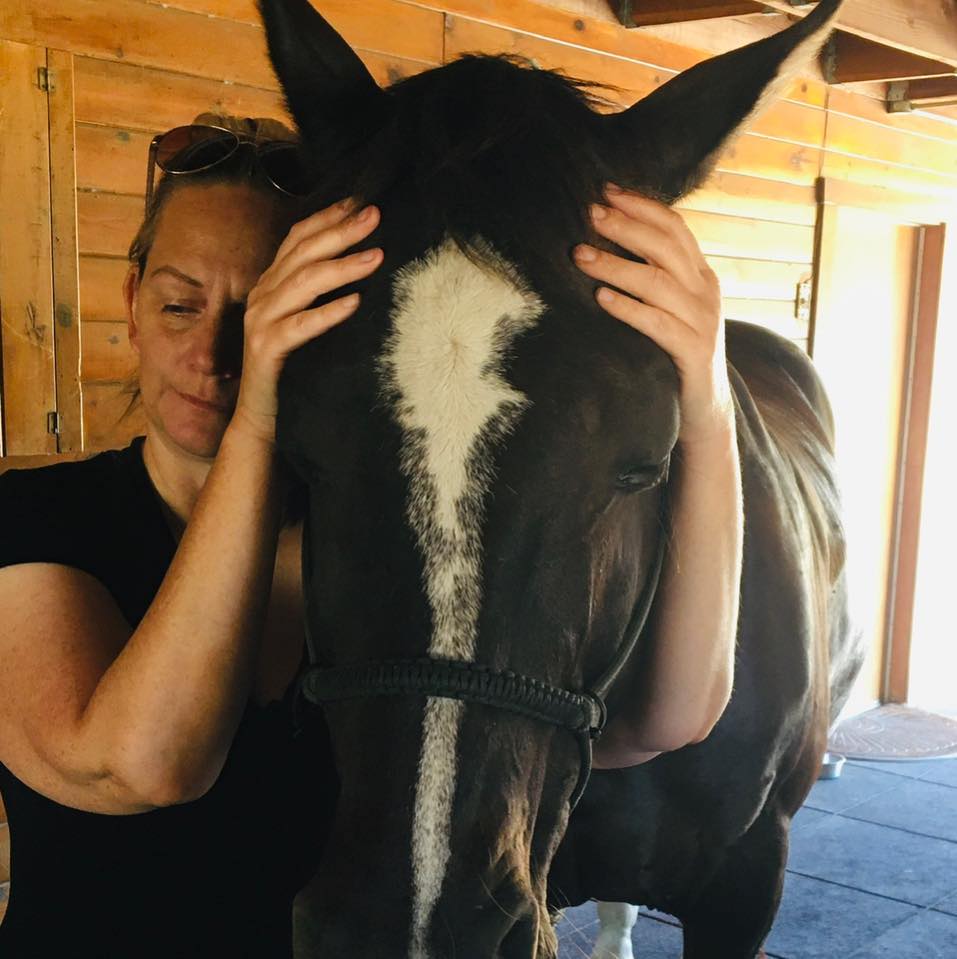UNCLENCHING THE JAW – A LOOK AT THE HORSE’S TEMPOROMANDIBULAR JOINT (TMJ)
I talk to clients regularly about the TMJ and how humans and horses clench their TMJ in response to their body discomfort and life stress in general.
This discussion is usually the result of conflicts and challenges that arise in ridden work with the horse.
Jaw clenching and TMJ immobility will end all impulsion, fluidity and suppleness in both horse and human.
There is a direct connection from TMJ to the scapula and to the ilium of the pelvic for both horse and human.
JAW CLENCHING – A RESPONSE TO STRESS AND PAIN
Jaw clenching happens in response to STRESS and PAIN, and most of it is involuntary!
Please remember both of these terms are very broad, and are expressed or triggered differently be each individual equine or human.
I have met plenty of riders and horses that just clench their jaw and hold their breath especially during ridden work. The combination of possible physical discomfort or pain on the horse’s behalf or rider, coupled with intensity of concentration and stress can trigger this reaction in both.
AN IMPORTANT JOINT
The TMJ joint is arguably the most important joint in the equine body.
The temporomandibular joint is comprised of the temporal bone and the mandibular bone. It is what we call an incongruent joint (defined as discrepancy between the joint surfaces) with a smaller ventral and larger dorsal component separated by an articular disk.
The muscles that work the joint are the masseter and temporalis muscles that close the jaw and pull it to the working side assisted by the medial pterygoideus muscles. The TMJ can have an effect on many muscles beyond the ones that work it, specifically those in the head, neck, face, shoulders and back.
The equine jaw works in grinding motion and an up and down motion. For optimum mobility it is important to have both motions in equal amplitudes in both joints. Often horses lose some of that mobility in one or both of their joints. Reduction in the range of motion of TMJ had body wide manifestations.
 FASCIA AND THE TMJ
FASCIA AND THE TMJ
Facially the TMJ has body wide connections on all three layers of fascia. Fascia has three layers – superficial, medial and deep. Each of those layers splits into three and then splits into three again so we have multiple layers of fascia. I’m giving you this information so your concept is a little more three dimensional than just three stacked layers .
I have often talked about how fascia suspends everything in our body and allows for gliding movement between those layers . Fascia responds almost instantly to push and pull and it is also loaded with proprioceptive and sensory fibers. It’s impossible to affect one area of fascia without it having body wide reactions.
This means clenching the jaw would create tension and pull towards it. Remember, there is a direct connection from TMJ to the scapula and to the ilium of the pelvic in both horse and human.
Neurologically, the TMJ is one of the most innervated joints in the horse’s body, sending information to the brain on vestibular balance, proprioception and posture as well as sensory input from cranial nerve CN5 (trigeminal). There is influence on the vagosympathetic trunk and a strong fascial connection to the viscera of the internal organs of the horse through the hyoid apparatus.
The stomatognathic system plays an important role in postural control. The stomatognathic system is a functional unit characterized by several structures, skeletal components maxilla and mandible, dental arches, soft tissues salivary glands, nervous and vascular supplies, and the temporomandibular joint and masticatory muscles. In particular, the temporomandibular joint makes muscular and ligamentary connections to the cervical region. The extensive afferent and efferent innervations of the stomatognathic system are reflected in the cerebral cortex.
If the proprioceptive information of the stomatognathic system is inaccurate, then head control and body position may be affected.
Posture refers to the position of the horse’s body and its orientation in space. Posture involves muscle activation that, controlled by the central nervous system, leads to postural adjustments. Postural adjustments are the result of a complex system of mechanisms that are controlled by multisensory inputs visual, vestibular, and somatosensory integrated in the central nervous system.
Postural adjustments improve through exercise and learning. These adjustments are evoked by several types of inputs, like sensitivity of feet, proprioceptive input (especially from the cervical, hip, fetlock, and carpel joints), and vestibular as well as visual movement of the surrounding environment.
In humans there is evidence that untreated temporomandibular disorders and malocclusion carry a risk of the development of postural disorders. Recent studies in humans emphasize the potential role of dental occlusion and of trigeminal sensory input in maintaining postural control.
Other studies further suggest that dental occlusion may influence body posture and spine curvature like scoliosis and lordosis.
The hyoid apparatus is a collection of bones that are suspended from the temporal bones and although not technically part of the TMJ it IS affiliated with the TMJ. The hyoid holds the larynx and pharynx which connect to the trachea and esophagus. The hyoid also holds the thyroid one of the master glands in the body. The hyoid apparatus is also the horses central gyroscope and plays an important roll in the stomatognathic system.
So here we just connected the TMJ to breathing, digestion and endocrine functions.
The TMJ joint is closely linked to the atlanto-occipital joint and the atlantoaxial joint. They are all interconnected through fascia and neurologically. Restriction in one will restrict them all to some degree, thereby locking the motion in the upper cervical spine which in turn will lock the sacrum and hind end.
This is just a glimpse of the iceberg that is the TMJ and what is affected by its immobility.
Each of the points mentioned is its own complicated universe of influence and function in a never ending circle of connection in the horse’s body.
I hope this begins to shed light on just how important it is to have fully balanced functional mobility in the TMJ joint.
WHAT DOES ALL OF THIS MEAN?
So… what can we do to help ? Luckily relaxing the TMJ and restoring some mobility can be simply accomplished by reducing stress, breathing and working the tissue and TMJ joint and occipital base to regain motion and mobility.
TRY THIS!
Try this little experiment – the next time you ride, open your mouth, hang your jaw and touch the tip of your tongue to the roof of your mouth.
Do this for ten or more strides and feel the change in your horse’s impulsion.
IF YOU LIKED THIS POST, YOU MAY ALSO ENJOY:
ONLINE COURSE: https://www.equitopiacenter.com/shop/equitopia-perspectives-horse-and-rider-asymmetry/
BLOG POST: https://www.equitopiacenter.com/caring-for-horses-after-a-visit-from-the-dentist-part-1/



